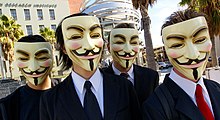Fictional resistance movements and groups
This article needs additional citations for verification. (December 2021) |

V for Vendetta used the image of Guy Fawkes for the leader of resistance to a fictional police state. This image is now used in the real world by groups such as Anonymous.[1]
Fictional resistance movements and groups commonly appear in dystopian fiction, opposing the tyranny which dominates the setting.
In literature[]
In Chuck Palahniuk's Fight Club, the tyranny is the soul-destroying life of modern western society. The protagonist rebels against this by organising atavistic bare-knuckle fights and then by leading Project Mayhem to destroy civilization. This story developed themes of alienation and anti-consumerism seen in earlier works such as Rebel without a Cause and The Prisoner with the epic, millennial quality of other contemporary works such as The Matrix.[2]
List of fictional resistance movements and groups[]
- Alice — An ex-employee of the Umbrella Corporation turned anti-Umbrella fighter willing to take down and destroy the same powerful evil megacorporation responsible for the Global T-Virus outbreak in Resident Evil.
- Alliance to Restore the Republic — also Rebel Alliance; the senators who wish to depose the Emperor and restore the Republic in Star Wars.
- Blake's 7 — eponymous rebels against the Terran Federation.
- The Brotherhood — the subversive opposition to The Party in George Orwell's Nineteen-Eighty Four.
- Chaos Insurgency — a splinter group of the SCP Foundation, created by a rogue task force that went A.W.O.L. with several SCP objects in 1924 and has been in opposition of the Foundation since.[3]
- Maquis — resistance to the Cardassians in Star Trek.
- — the underground rebels getting ready to revolt against OneState in We (novel) by Evgeny Zamyatin.
- Merry Men — mythical English band of outlaws lead by Robin Hood opposed to the Sheriff of Nottingham.
- The Order of the Phoenix, Dumbledore's Army - underground resistance to Voldemort and his Death Eaters in Harry Potter and the Deathly Hallows
- La Résistance — movement of the children of South Park, Colorado opposing the United States' war against Canada as instigated by Mothers Against Canada in South Park: Bigger, Longer & Uncut.
- The Resistance — network of humans and vortigaunts fighting the Combine in Half-Life 2.
- The Resistance — the senators who wish to depose the Supreme Leader and restore the New Republic in Star Wars.
- Song Jiang — leader of outlaws during the Song Dynasty and fictionalized in the Water Margin
See also[]
- Fictional secret societies
- Terrorism in fiction
References[]
- ^ Emily McAvan (2012), The Postmodern Sacred: Popular Culture Spirituality in the Science Fiction, Fantasy and Urban Fantasy Genres, p. 163, ISBN 9780786492824,
as with the use of the iconic Guy Fawkes mask from the Wachowskis' V For Vendetta as a symbol of anonymous resistance at protests
- ^ John M. Stoup, Glenn W. Shuck (2007), "God's Unwanted: Fight Club and the Myth of "Total Revolution"", Escape Into the Future: Cultural Pessimism and Its Religious Dimension in Contemporary American Popular Culture, Baylor University Press
- ^ TwistedGears (6 July 2014). "Chaos Insurgency Hub". SCP Foundation Wiki. Retrieved 28 October 2021.
Further reading[]
- Junius P. Rodriguez (2007), Encyclopedia of Slave Resistance and Rebellion, Greenwood Publishing Group, ISBN 9780313332722
Categories:
- Lists of fictional organizations
- Fictional revolutionaries
- Fictional revolutionary organizations
- Literature stubs
- Sociology stubs